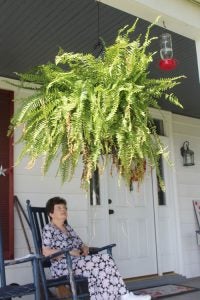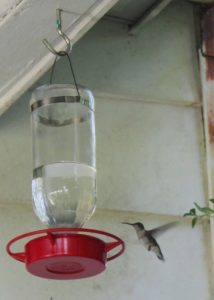Hummingbirds find banquet on Orbit Road
Published 7:00 pm Friday, August 2, 2019

- Enjoy the pause that refreshes. Two hummingbirds sit still long enough to feed on the sugar water mixture that Carrie Osmundson made earlier that day. Stephen H. Cowles | Tidewater News
Carrie Osmundson enjoys watching as they feast at her porch
ORBIT

Carrie Osmundson patiently waits for hummingbirds to drink from the feeders she’s got on the front porch of her home on Orbit Road. Stephen H. Cowles | Tidewater News
Hummingbirds on Orbit Road know where they can find a free meal — on the front porch at the home of Carrie Osmundson.
The former Hampton resident credits Imogene Babb (“a lovely neighbor”) for introducing her to the presence of the nimble little birds, and decided in 2007 to start setting up ways to attract them to her home as well.
“I started off with a couple of feeders, and now I’m up to a dozen,” said Osmundson, who noted that the hummingbirds favor those in the shady area of her porch.
As would be expected, that time spent has led her to observe a few things about their behavior, especially when it comes to feeding time. When the trays are loaded with the sugar water, the guys get first dibs.
“The males are dominant — the girls wait their turn,” Osmundson said. “They will fight for the territory. They’re very, very territorial, and will fly and chase each other and come in front of your face.”
According to www.audubon.org, hummingbirds flap their tiny wings up to 90 beats per second. That requires eating a lot, and so they eat half their body weight in nectar and bugs, and will feed every 10 to 15 minutes.
To keep them nourished, she fills the bottles just about every day. On Friday morning, for example, seven of the 12 needed replenishing. The recipe is simple. Osmundson said that for every gallon of boiling water, she adds four cups of granulated sugar and that’s mixed until dissolved. Only the refined white sugar must used, no substitutes such as honey or artificial sweeteners, and certainly no red dyes to color the homemade nectar. Even www.audubon.org said the coloring isn’t needed and the chemicals could hurt them.
For the past two to three years, the tiny jewel-toned birds have arrived at her place on or about the nine of April for the past two to three years. She added that wasps show up after the first spell of hot dry weather, usually in May. Which leads her to say that another way to attract the hummingbirds is by discouraging wasps.
“Hummingbirds fear wasps because their stings could kill them,” said Osmundson. “If a wasp is spotted at a feeder, they’ll go somewhere else.”
Interspersed between the feeders are small brown paper bags filled with more paper or even plastic bags. The wasps, she explained, then think those are nests belong to others of their kind and will stay away.
Taking photographs of the hummingbirds is a bit of a challenge. They rarely stand still for any length of time. Instead, they take quick nips and move to another feeder or elsewhere.
As Osmundson watches from a chair on the porch, her rescue beagle Molly will occasionally move back and forth to the yard and back, sometimes barking at the birds. They quickly zip away, but return as soon as the coast is clear.
The hummingbirds won’t stay indefinitely in spite of Osmundson’s generosity. When the weather turns cooler, the majority will make their way to warmer climates and more food in southern Texas and Mexico or further down in Central- and South America. She’s had stragglers and passers-through as late as the first of October.
Meanwhile, said Osmundson, “I enjoy just sitting out and watching them.”






